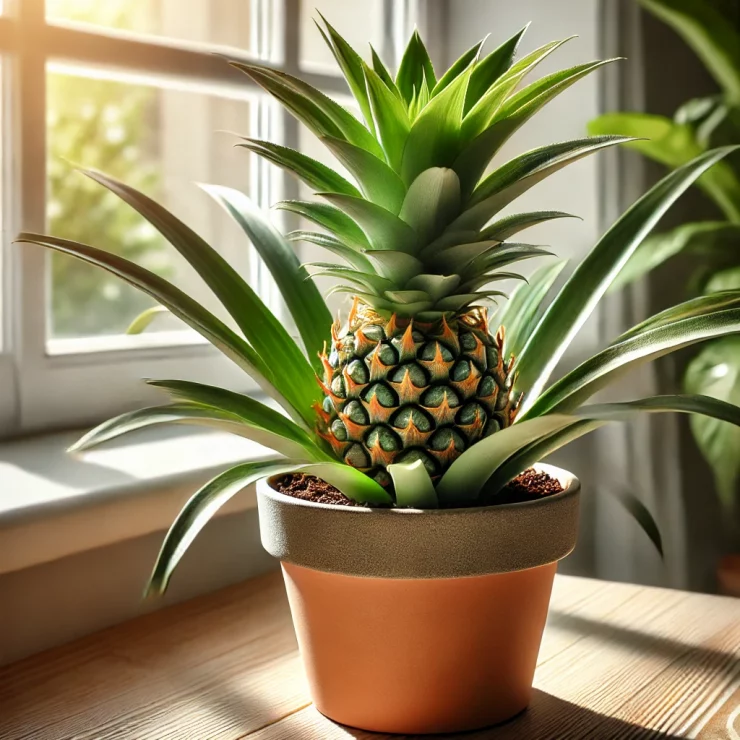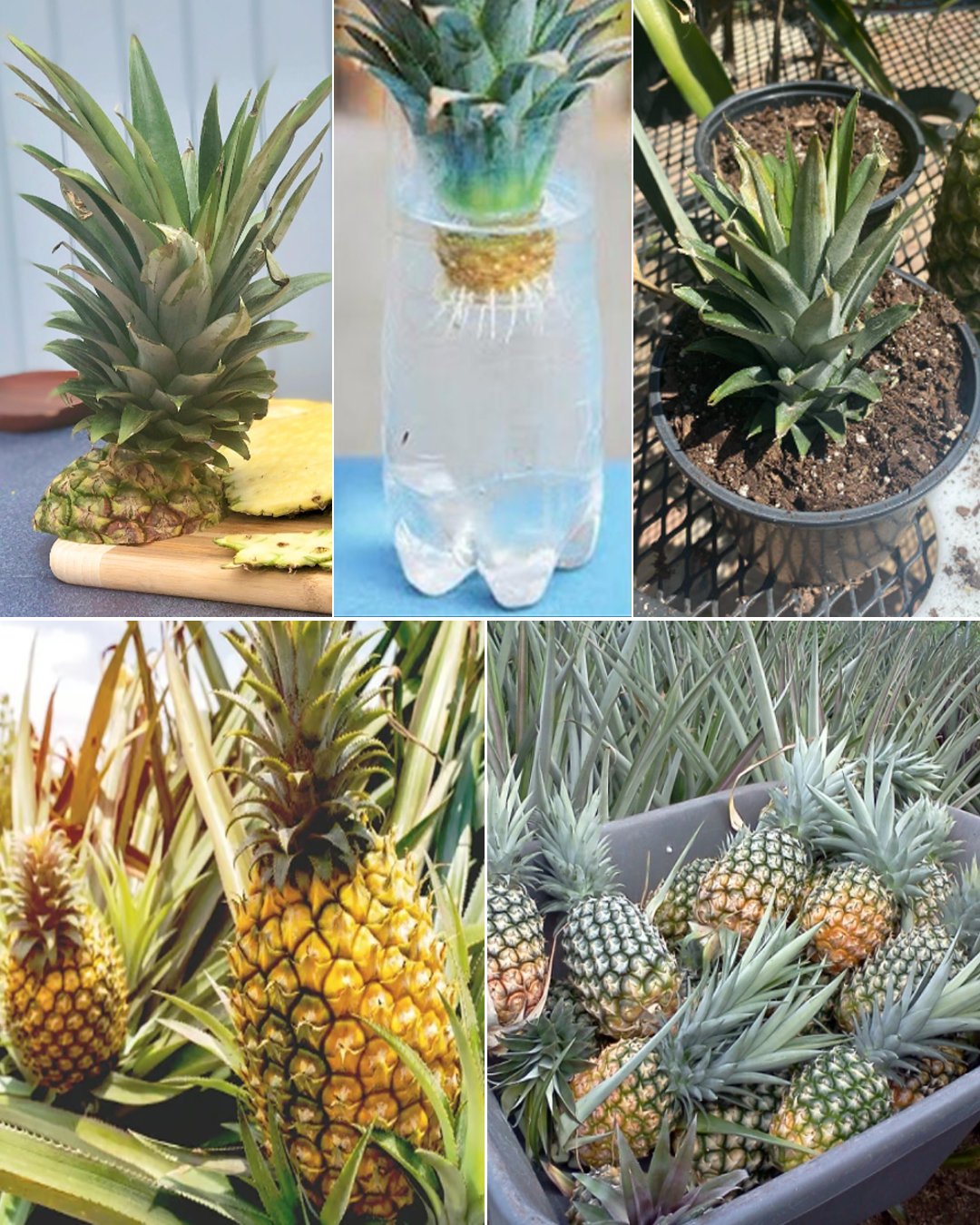Growing pineapples at home may seem like a tropical dream, but it’s surprisingly easy to do, even if you don’t live in a warm climate. With a little patience and the right technique, you can enjoy the satisfaction of growing your own pineapples right in your backyard, garden, or even indoors. Here’s a step-by-step guide on how to grow pineapples at home fast and easy.

1.Choose the Right Pineapple
The first step to growing pineapples at home is to select a healthy, ripe pineapple from your local grocery store or farmer’s market. Look for a pineapple with bright green leaves and a firm, golden-yellow body. Avoid pineapples that are overly soft, brown, or have wilting leaves, as these may not be viable for planting.
Tips:
Choose a pineapple that has a full crown of leaves.
Ensure the pineapple is ripe but not overripe, as you’ll need the crown to be in good condition.
2.Prepare the Pineapple Crown
Once you’ve selected your pineapple, it’s time to prepare the crown (the leafy top) for planting. Here’s how:
Steps:
Twist off the Crown: Hold the body of the pineapple in one hand and the crown in the other. Twist the crown until it separates from the fruit. Alternatively, you can cut off the top of the pineapple with about an inch of fruit attached.
Remove Lower Leaves: Carefully strip away the lower leaves from the crown, revealing about 1-2 inches of the stem. This is where roots will form.
Dry the Crown: Let the crown dry out for a day or two in a warm, dry place. This helps prevent rot when you plant it.
3.Root the Pineapple Crown
Before planting the pineapple crown in soil, it’s important to encourage root growth. You can root the crown in water or directly in soil.
Water Method:
Place the pineapple crown in a glass of water, submerging the base but not the leaves.
Change the water every few days to keep it fresh.
After a few weeks, you should see roots forming. Once the roots are about 2-3 inches long, the crown is ready to be planted.
Soil Method:
If you prefer to skip the water stage, you can plant the crown directly in a pot with well-draining soil.
Press the crown into the soil so that the lower part of the leaves is just above the soil surface.
Water lightly to keep the soil moist but not soggy.
4.Plant the Pineapple
Once your pineapple crown has developed roots, it’s time to plant it in a more permanent location. Pineapples grow well in pots, containers, or directly in the ground if you live in a warm climate.
Planting in a Pot:
Choose a large pot (at least 12 inches deep) with good drainage.
Fill the pot with a well-draining potting mix. A cactus or succulent mix works well.
Plant the pineapple crown in the center of the pot, burying the root base in the soil and leaving the leaves above the surface.
Water the plant thoroughly and place it in a sunny spot.
Planting in the Ground:
If planting outside, choose a sunny spot with well-draining soil.
Dig a hole big enough to accommodate the roots and plant the crown at the same depth it was in the pot.
Water the plant well and mulch around the base to retain moisture.
5.Care for Your Pineapple Plant
Pineapples are relatively low-maintenance plants, but they do require some basic care to thrive.

Light: Pineapples need plenty of sunlight to grow well. Aim for at least 6-8 hours of direct sunlight each day. If you’re growing your pineapple indoors, place it near a bright, sunny window.
Watering: Pineapples prefer slightly dry conditions, so water them sparingly. Allow the soil to dry out between waterings to prevent root rot. During the warmer months, water more frequently, but reduce watering in winter.
Fertilizing: Feed your pineapple plant with a balanced fertilizer every few months during the growing season (spring and summer). Pineapples are light feeders, so don’t over-fertilize.
Temperature: Pineapples thrive in warm temperatures. If you’re growing them indoors or in a cooler climate, ensure they are kept in a warm location, ideally between 65-95°F (18-35°C).
6.Be Patient
Growing pineapples at home requires patience. It can take 18-24 months for your plant to produce a fruit, but the wait is well worth it. During this time, the plant will continue to grow and may even produce “pups” or “slips” (small offshoots) that can be removed and replanted to grow new pineapple plants.
Signs of a Pineapple Fruit:
After 18-24 months, you may notice a flower emerging from the center of the plant.
The flower will eventually develop into a small pineapple fruit.
Allow the fruit to ripen on the plant until it reaches a golden color and gives off a sweet aroma.
7.Harvesting Your Pineapple
Once the pineapple is ripe, it’s time to harvest! Simply twist the fruit off the plant or use a sharp knife to cut it at the base.
Tips for Harvesting:
Wait until the pineapple is fully ripe before harvesting to ensure the best flavor.
After harvesting, the plant may produce more offshoots, allowing you to start the process again with new plants.
Growing pineapples at home is a fun and rewarding project that doesn’t require much space or special equipment. By following these simple steps, you can enjoy the satisfaction of growing your own tropical fruit right in your backyard or even indoors. With a little patience and care, you’ll be able to harvest a delicious, homegrown pineapple and impress your friends and family with your gardening skills.
News
JJ Redick reacts to Luka Doncic trade for Anthony Davis
In one of the most jaw-dropping moves of the season, the NBA landscape was rocked by the blockbuster trade involving Luka Dončić and Anthony Davis—a swap that has sent ripples of excitement, disbelief, and heated discussion through the league. Among…
Anthony Davis FULL reaction to trade to Mavericks for Luka Doncic
In a blockbuster move that sent shockwaves through the NBA and left fans reeling, Anthony Davis has been traded to the Dallas Mavericks in exchange for Luka Dončić. In the immediate aftermath of the news, Davis took to the media…
Shaq reacts to Dallas Mavericks wanting Kevin Durant after Luka-AD trade 👀
In the constantly shifting world of the NBA, trade rumors and blockbuster moves are a regular part of the season’s drama. The latest twist has fans buzzing: the Dallas Mavericks have reportedly set their sights on acquiring Kevin Durant in…
Donovan Mitchell FILTHY poster dunk on Kristaps Porzingis 😳
In a game filled with high-intensity moments and jaw-dropping highlights, one play in particular has left fans and analysts buzzing about Donovan Mitchell’s latest display of athleticism. Early in the contest, with the atmosphere already charged by an evenly matched…
Joel Embiid hits go-ahead bucket vs Mavs then chats with Anthony Davis after game
In one of the most thrilling contests of the season, Joel Embiid delivered a clutch performance against the Dallas Mavericks, punctuating the game with a go-ahead bucket that sent the home crowd into a frenzy. The atmosphere in the arena…
D’Angelo Russell game winner as Nets hit two 3’s in 3 seconds to win vs Rockets 😱
In one of the most electrifying moments in recent NBA history, D’Angelo Russell delivered an unforgettable game-winner that left fans and commentators in complete awe. With the Brooklyn Nets locked in a tense battle against the Houston Rockets, the outcome…
End of content
No more pages to load











